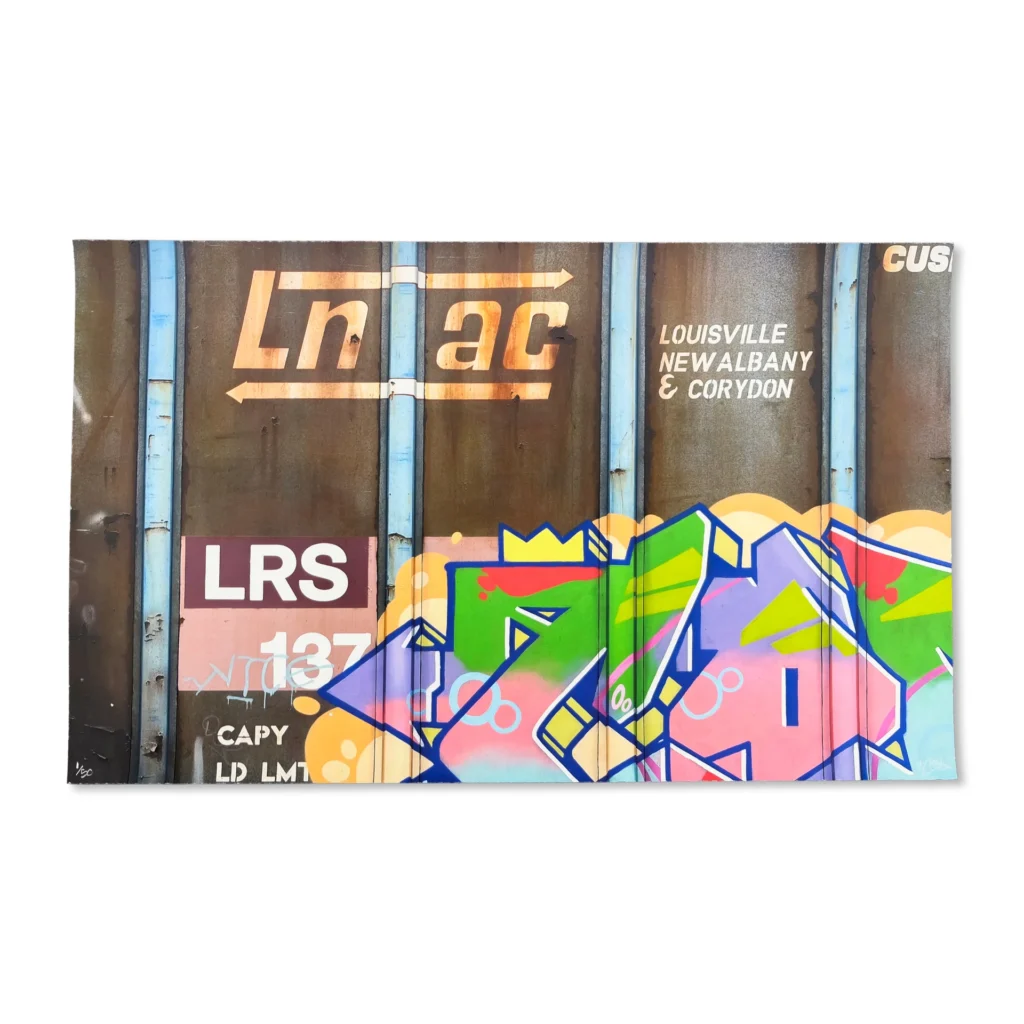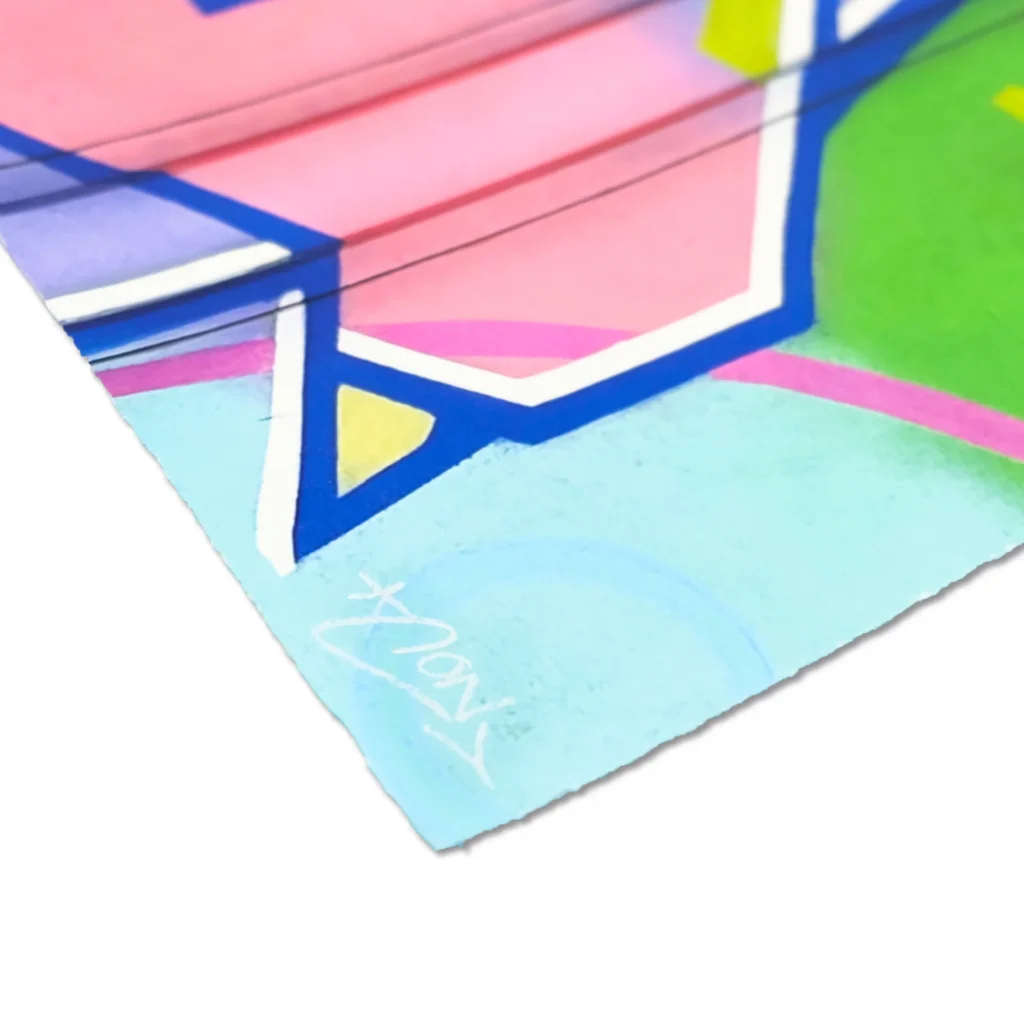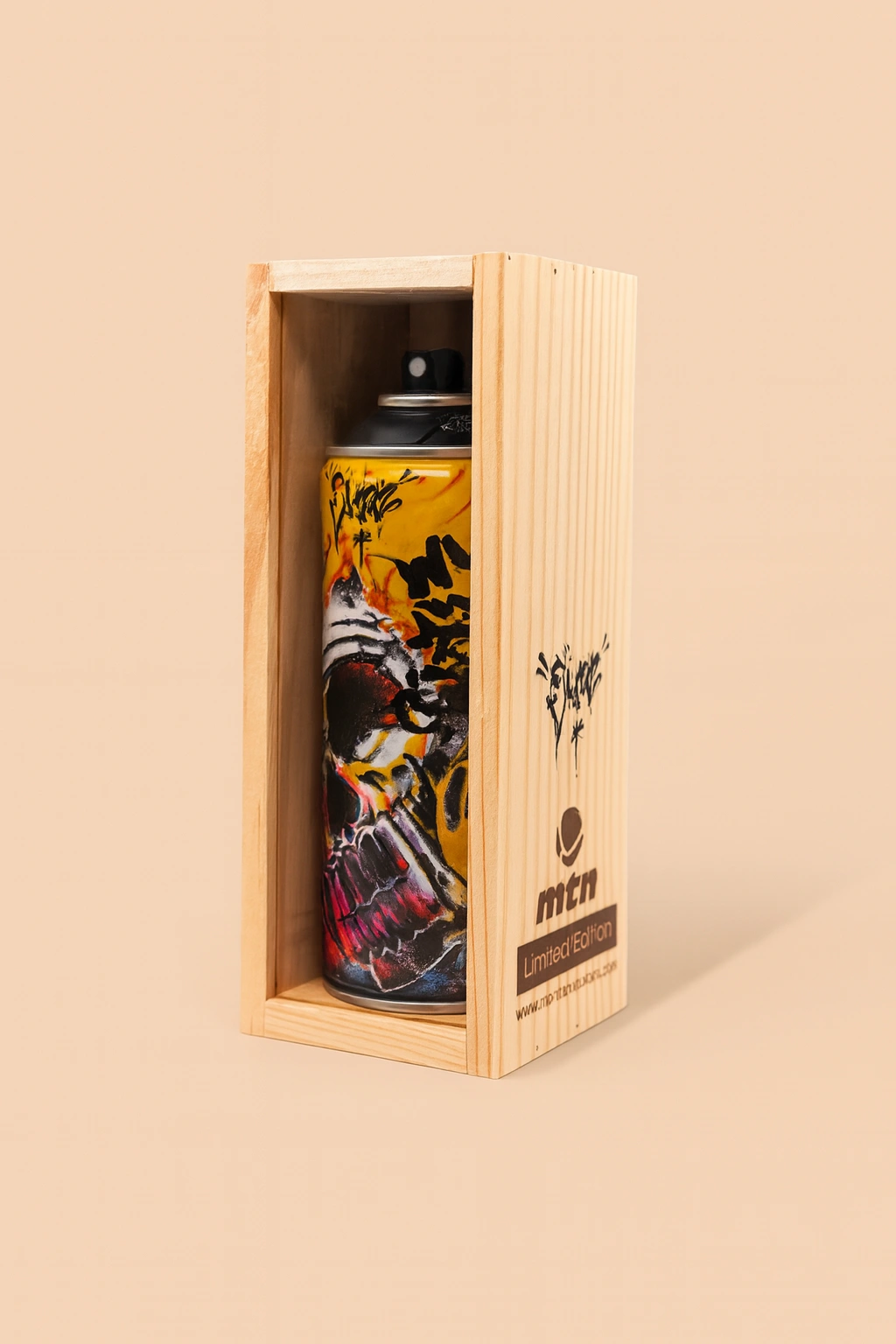In Blank Canvas #118 – LRS, 2025, Tim Conlon offers a compelling intersection of fine art and street culture, bringing the raw authenticity of graffiti into the clean, deliberate space of contemporary art. A gicleé print on heavy cold press paper with a deckled edge, this 22 x 36-inch piece is part of a limited edition of 50, each one hand-signed by the artist. Conlon’s ongoing Blank Canvas series has become a defining body of work that reinterprets freight train graffiti with painterly precision, and this edition represents one of its most visually captivating entries.
This piece does not simply reproduce graffiti—it translates it. Conlon’s work is rooted in the real world of freight train graffiti, where artists, often anonymous, express themselves across the continent, creating fleeting public exhibitions that traverse cities and states on steel canvases. With Blank Canvas #118 – LRS, Conlon isolates a section of a boxcar, transforming a transient piece of the rail yard into a permanent, contemplative artwork.
The illusionistic quality of the piece is achieved through meticulous technique. The trompe l’oeil (or “fool the eye”) approach gives viewers the uncanny sensation of standing in front of an actual rusted train car. The weathered metal surface, faded typography, and bolt lines are all rendered in such high fidelity that one might initially mistake it for a photograph. Yet, upon closer inspection, the layering of paint, subtle brushwork, and choice of color mark it unmistakably as a painting. This duality—the push and pull between realism and painterly abstraction—creates a tension that is at the heart of Conlon’s practice.
Dominating the composition is a vibrant section of graffiti that contrasts boldly with the worn, industrial background. Painted in luminous greens, purples, pinks, and blues, the graffiti lettering slices diagonally across the frame, partially obscuring railroad reporting marks and faded logos such as “LRS,” “137,” and “Louisville New Albany & Corydon.” The layering of text and color evokes the layered history of real freight cars, which often bear the marks of time, travel, and multiple artists. Conlon’s application of spray paint techniques onto canvas mirrors the process used in train yards—quick, energetic, and highly stylized—yet is executed with the control and permanence of fine art.
In this print, Conlon blends several different visual languages. There’s the bold and aggressive stylization of graffiti writing, often coded and only legible to those within the culture. There’s the structured, utilitarian design of railroad signage, built for clarity and function. And then there’s the painterly abstraction that peeks through—misty overspray, subtle gradients, and lush fields of color that anchor the piece in the world of traditional studio painting. These elements don’t compete; they converse. Conlon doesn’t merely reproduce what’s seen on trains—he reinterprets it, elevates it, and challenges our understanding of where graffiti can exist in the hierarchy of art.
What makes this work especially powerful is its ability to evoke place and culture. For decades, the American freight train has served as both a literal and symbolic vehicle for movement, connection, and subversion. Graffiti writers have used it as a medium not only to communicate but to resist erasure—tagging their names and crews in spaces that travel across the continent, beyond the reach of traditional art spaces. Conlon, a veteran of this world, doesn’t romanticize it. Instead, he presents it with reverence and authenticity, preserving moments that would otherwise disappear under layers of grime, buffing paint, or time.
The choice to use a deckled edge and cold press paper furthers the tactile quality of the piece. It’s a nod to traditional printmaking, grounding this modern, urban subject in the lineage of fine art. The signed edition of 50 also creates a sense of intimacy and rarity—each one is a personal artifact from the artist, who bridges the gap between graffiti writer and studio painter with remarkable fluency.
Conlon’s inclusion of iconic railroad abbreviations and destinations—“LRS,” “Louisville New Albany & Corydon”—functions on multiple levels. For those unfamiliar with rail culture, they might pass as abstract text or industrial ephemera. For those in the know, they are deeply specific references that ground the piece in a lived geography and a shared visual language. It is this dual-read—the accessible aesthetic appeal and the insider knowledge—that makes Conlon’s work both inviting and intricate.
The Blank Canvas series as a whole acts as a living archive, a visual diary of freight culture in America. Each piece is a tribute to the ephemeral nature of graffiti, a record of a moment that might no longer exist in the real world. Conlon’s practice ensures that this subculture is not just preserved but celebrated in a formal art context. He challenges the viewer to consider what qualifies as art, what deserves preservation, and how context alters value.
In Blank Canvas #118 – LRS, we are reminded that graffiti is not just vandalism or rebellion—it is communication, heritage, and, in the hands of artists like Conlon, a sophisticated form of visual expression. This print is more than a reproduction; it is a document, a painting, and a bridge between worlds. It invites us to look closer, to recognize the beauty in the overlooked, and to respect the history riding the rails.
As the boundaries between street art and fine art continue to blur, works like Blank Canvas #118 – LRS reaffirm the validity of graffiti within the canon of contemporary art. Conlon’s ability to honor the roots of his culture while innovating its presentation speaks to a mature, thoughtful practice. This edition, published by BEYOND THE STREETS, is both a collector’s item and a cultural artifact—a snapshot of an ever-evolving dialogue between movement, place, identity, and mark-making.
No comments yet.









